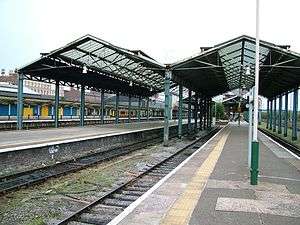Chester General rail crash
The Chester General rail crash occurred on 8 May 1972 at Chester railway station (traditionally known as Chester General station) in northwest England.
| Chester General rail crash | |
|---|---|
 Chester Station seen in 2005, showing the section of roof that was not replaced | |
| Details | |
| Date | 8 May 1972 20:50 |
| Location | Chester railway station, Chester, England. |
| Coordinates | 53°11′47″N 2°52′41.7″W |
| Country | |
| Line | Chester to Manchester Line |
| Incident type | Collision, derailment, fire |
| Cause | Failure to connect vacuum brake pipes to the locomotive |
| Statistics | |
| Trains | 2 |
| Deaths | 0 |
Course of events
The 19:31 freight train from Ellesmere Port to Mold Junction consisted of 38 wagons hauled by a Class 24 diesel locomotive no. 5028. The first five wagons were tank wagons containing kerosene, petrol and gas oil.
At around 20:50 the train was approaching Chester on a 1 in 100 falling gradient when the driver discovered that the brakes had failed. It ran past a signal at danger and through a set of points which were set for no. 11 bay platform, where an empty diesel multiple unit was standing.
As there was nothing more he could do, the driver jumped out onto the platform with the train still travelling at around 20 mph. It ploughed straight into the DMU and completely destroyed the first coach. The second coach was torn from its bogies and thrown up onto the platform where it demolished the refreshment room wall. There were very few people on that part of the station, although the staff in the refreshment room had to shelter themselves from falling masonry.
A major fire broke out when the burst fuel tanks of the trains ignited, but the fire brigade were based nearby and arrived within a couple of minutes. They were able to rescue a trapped postal worker and evacuated several passengers from an adjacent lightly loaded train before it too was engulfed by the fire.
Damage caused to the trains was severe, especially after petrol from two of the tank wagons began to boil and was forced out of the pressure relief valves, whereupon it ignited. The fire was not extinguished until 00:20 the following day.
The trains involved were all written off and a section of the station roof was damaged and consequently removed.
Causes
The first eight wagons were equipped with the vacuum brake but the pipes had not been connected. The train had run from Ellesmere Port as an unbraked freight train and stopped at Helsby, where it needed to reverse. The guard had forgotten to connect the vacuum pipes when the locomotive coupled up to the opposite end of the train, so that extra brake power was not available on the falling gradient into Chester. The driver had also omitted to carry out a brake test before departure.
External links
See also
- Lists of rail accidents
- List of British rail accidents
References
- Hall, Stanley (1989). Danger on the Line. Ian Allan.
- Ministry of Transport; Maj P M Olver (1974). Railway accident : report on the Derailment and Consequent Fire that occurred on 8th May 1972 at Chester General Station in the London Midland Region British Railways (PDF). HMSO. ISBN 0-11-550351-X.